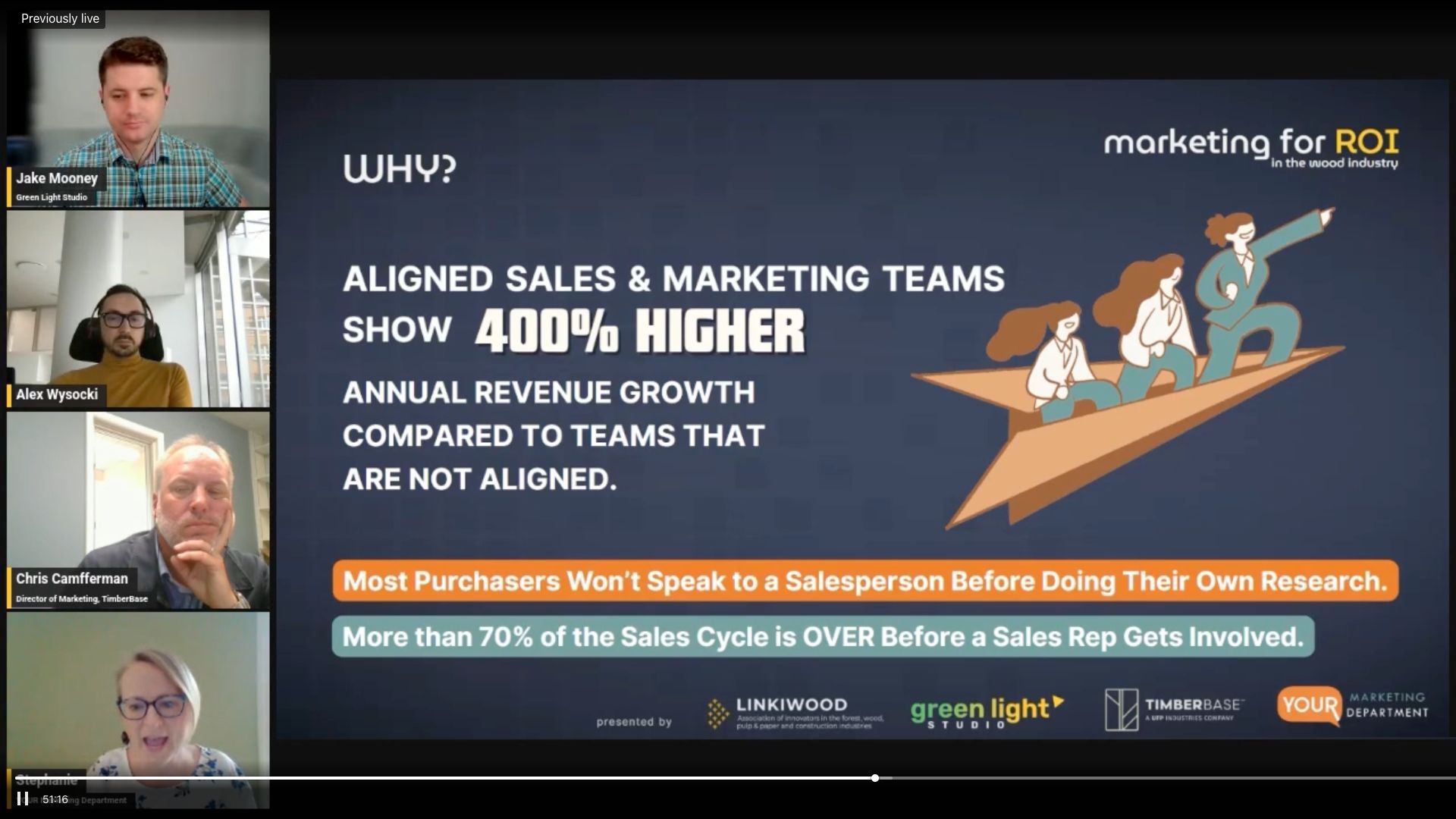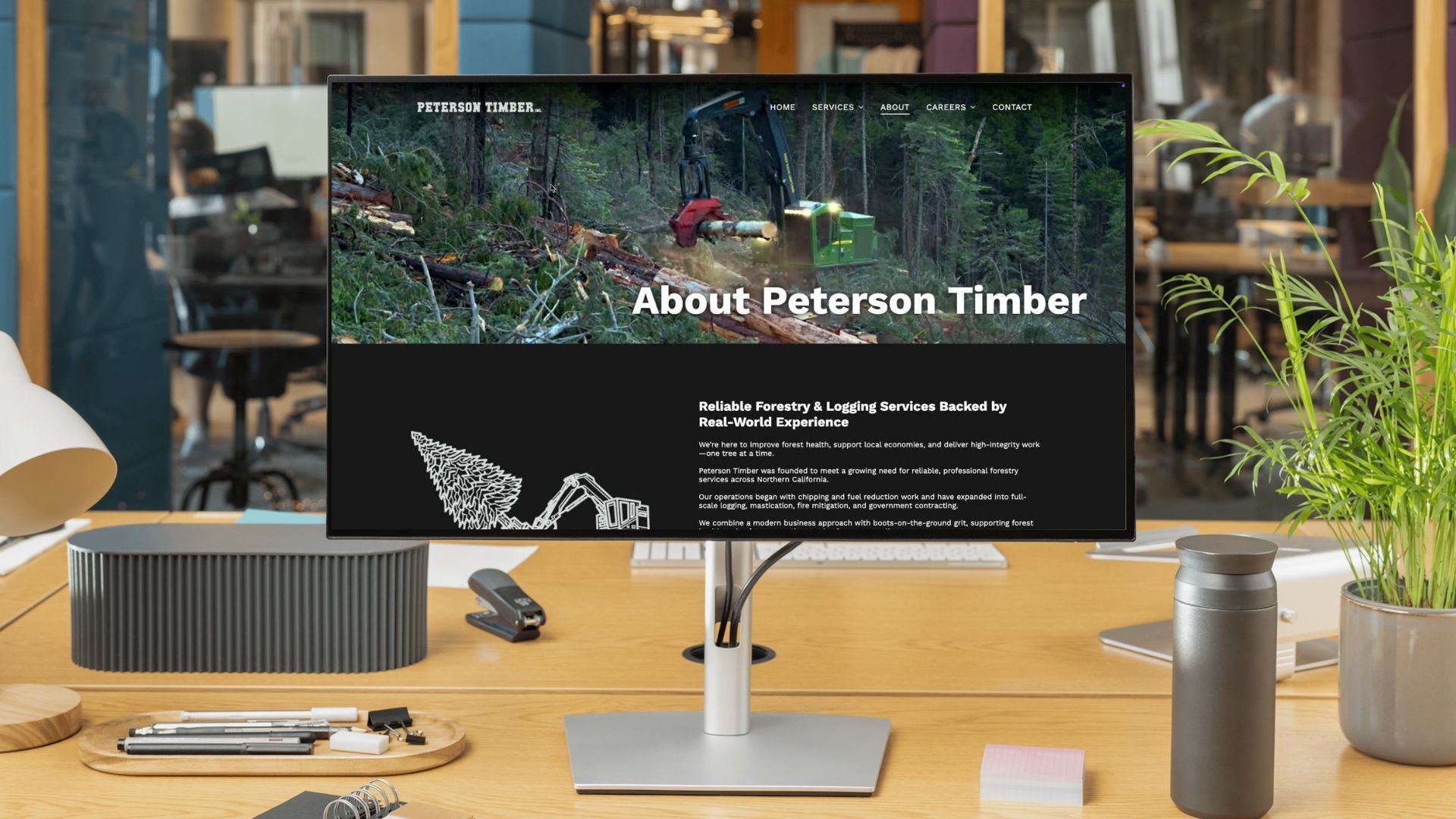
When Marketing Is Treated Like a Service Desk, Everyone Loses
If you’ve ever sat in a meeting where sales is asking for a flyer, the GM wants a product video “by Friday,” and you’re still chasing someone for pricing details, you know the feeling. You’re in the room, but you’re not really part of the conversation. You’re there to color things in.
That’s not just frustrating, it’s dangerous.
Jake Mooney, founder of Green Light Studio, remembers one of his earliest experiences in the timber industry. It wasn’t a strategy session. It was a survival moment.
“I was asked to sit with [a sales specialist] and not come out of the room until we had the industrial sales catalog mapped out. I’m sitting there with a pen, an old catalog, and no clue about sawmills.”
That pressure to produce something, anything, fast, without context or insight, is something many marketers know too well.
Why does this happen?

“Management or sales often viewed marketing as just the people who color pictures,” “Concerned with whether you used the logo in the right color… basically irrelevant.”
That mindset doesn’t just hurt morale. It keeps companies invisible in the market. It leads to inconsistent messaging, missed opportunities, and wasted internal resources trying to patch up the fallout from misaligned decisions.
“When marketing is viewed just as an internal service provider, there's a five-letter word for that I can't say on air. You’re just taking orders. You're not involved strategically.”
This lack of strategic involvement becomes a self-reinforcing cycle. Marketing isn’t brought in until something is broken. Then they’re blamed for not fixing it fast enough.
“There's a huge negative impact when marketing doesn't get a seat at the table. A lot of times management doesn't even know what they’re missing out on.”
And what they’re missing out on is more than just marketing performance. It’s positioning. Brand clarity. Trust with dealers and customers. Even internal communication suffers when marketing isn’t part of the big picture.
In one case Jake shared, the consequences were immediate and obvious. Global marketing had carefully prepared a unified branding system consistent visuals across multiple product lines. But management rejected it.
“Six months later at the world’s biggest tradeshow in their industry, they saw the mess it created and changed their minds.”
That kind of disconnect leads to slowdowns, frustration, and even reputational damage. Not because marketing did something wrong, but because marketing wasn’t allowed to do anything at all until it was too late.
Why the Disconnect Happens
When marketing is treated like a support desk, it’s not always because leadership is hostile. Often, they simply don’t understand what modern marketing is capable of, or they’ve never seen it done well in a business like theirs.
Jake Mooney has seen this pattern again and again. From timber equipment dealers to manufacturing firms, the problem often starts with how marketers explain their work.
Too often, we focus on what we made, not what it did.
“I used to walk into meetings with a list of things we’d published. Blog posts, social stats, videos. But that doesn’t answer the question every executive is asking, ‘What did this do for the business?’”
Executives are dealing with a different kind of pressure: margins, recruiting, distributor satisfaction, and board-level growth goals. If marketers are speaking in branding terms instead of business terms, it’s no wonder the message doesn’t land.
“Frame it their way. Tie your work to their goals. Make it easy for them to say yes and to take the credit for it.”

This shift isn’t about pandering. It’s about alignment. You need to show that marketing is not a cost center, it’s a tool for solving leadership’s most pressing problems.
Jake shared a story that drove this home.
In one case, a new product had launched. Marketing was told to create demand. So Jake visited a dealer to ask for feedback.
“In one case, I asked a dealer what they thought about a new product that had just launched. They said, ‘What new product?’”
There had been no internal communication. No rollout plan. No handoff between departments. Marketing had been asked to run a race with no baton.
Jake’s response? Step in and solve the real problem.
“There was no ownership across departments to communicate with dealers. So marketing stepped in. Every six weeks for six years, I managed an internal newsletter to fix that.”
That newsletter became a linchpin of internal alignment. It wasn’t flashy. It wasn’t even marketing’s core priority. But it solved a real problem.
“We solved this problem for management. It was not marketing's biggest priority... but suddenly, they started looking at us in a different light.”

This is how marketing earns a seat at the table: not by shouting louder, but by being useful in the ways that matter to leadership.
“That's kind of the point of this whole thing: make management marketing’s biggest cheerleader.”
The way forward isn’t waiting for recognition. It’s solving business problems and letting the impact speak for itself.
Here’s Section 3 fleshed out with accurate quotes from Jake and grounded in real-world B2B leadership dynamics:
How to Get Buy-In for New Initiatives
Once you’ve started earning trust by solving small problems, the next step is getting support for bigger ideas. But here’s the catch: if you pitch those ideas as marketing needs, they’ll often get ignored. Jake Mooney recommends a different approach.
“Be proactive. Don’t wait for leadership to ask. Anticipate their pain points and bring ready-made solutions.”
It starts with understanding what executives actually care about - delays, lost deals, inefficient handoffs, frustrated distributors. If you can frame your proposal in their terms, it becomes much easier to get a yes.
Jake shared his mindset when bringing new ideas to management:
“Basically go, ‘Hey, I see you have a pain point. I was talking to a distributor. We could do this. And we’re ready to do it.’ Not: ‘You should do that. You should delegate someone.’”
He compares it to parenting.
“I’m a dad of five kids. My kids tell me that kind of stuff all the time. They don’t come with ready-made solutions.”
The message is clear: make it easy for leadership to approve your idea. Show them what’s broken, how it affects them, and how you’ve already prepared a low-effort fix. This shows initiative and removes friction from the decision.
“Several times, I got management to approve something they had no idea they were going to approve that day, because I showed them a problem that affected their concerns, not marketing’s.”
He even suggests you make management the hero of the solution.
“Treat your management as a client, or almost as the hero. Marketing’s role is to be the trusted guide that helps them succeed.”
When marketing shows up as a strategic partner solving problems, without adding stress or extra work, leadership doesn’t just approve your projects. They start relying on you.

The Goal: Become a Strategic Partner, Not a Service Desk
Marketing’s long-term success doesn’t come from flashy ideas. It comes from consistently showing up as a reliable, solution-oriented partner inside the business.
Jake Mooney has seen firsthand what happens when marketing earns that kind of role.
“We solved this problem for management. It was not marketing's biggest priority... but suddenly, they started looking at us in a different light.”
In that case, marketing stepped in to run an internal newsletter for distributors, something no other department wanted to own. It wasn’t glamorous, but it fixed a real communication issue. And that earned trust.
Jake’s bigger point?
“That's kind of the point of this whole thing, make management marketing’s biggest cheerleader.”
You don’t earn that by asking for a seat at the table. You earn it by being useful on their terms, over and over again. That means solving friction. Supporting sales. Fixing operational problems before chasing campaigns.
It also means changing your mindset. You’re not just “running marketing.” You’re enabling momentum across the business.
“Frame it their way. Tie your work to their goals. Make it easy for them to say yes and to take the credit for it.”
That shift, from asking for buy-in to delivering aligned solutions, is how marketers get invited into strategic conversations. It’s how you go from being the “flyer person” to being the person leadership calls when they need something done right.
“When marketing is viewed just as an internal service provider, there's a five-letter word for that I can't say on air. You’re just taking orders. You're not involved strategically.”
“There's a huge negative impact when marketing doesn't get a seat at the table. A lot of times management doesn't even know what they’re missing out on.”

You Don’t Need Permission to Start
Marketing alignment isn’t something you wait for. It’s something you build.
Jake Mooney emphasized that no one hands marketers authority out of the blue. It’s earned by changing how you work and how you show up:
“Be proactive. Don’t wait for leadership to ask. Anticipate their pain points and bring ready-made solutions.”
Start small. Focus on one area where you know marketing could reduce friction or create forward motion. Maybe it’s improving how distributors get product updates. Maybe it’s streamlining what sales sends to leads. Whatever it is, frame it around business impact.
“Basically go, ‘Hey, I see you have a pain point. I was talking to a distributor. We could do this. And we’re ready to do it.’ Not: ‘You should do that. You should delegate someone.'”
Make their job easier, not harder. That’s how you earn trust and how you get to say something like this:
“Several times, I got management to approve something they had no idea they were going to approve that day, because I showed them a problem that affected their concerns, not marketing’s. When you do that, the yeses come.”
Marketing earns a voice at the table when it becomes the guide leadership didn’t know they needed. Not the star of the show, but the one helping the hero win.
“Treat your management as a client… or almost as the hero. Marketing’s role is to be the trusted guide that helps them succeed.”
Next Steps
If you're trying to reposition marketing as a strategic partner inside your industrial business:
- Start with one real business problem marketing can help solve
- Build one simple dashboard that reports impact in plain terms
- Ask one executive: “What would make you see marketing as a growth driver?”
Then build from there. Bit by bit, show, not tell, how marketing moves the business forward.
“You’re not just in charge of content,”
“You’re in charge of momentum. Start owning that, and people will start treating you differently.”
Unimpressed with your marketing?
Get support and direction with these resources:
- Free Marketing Audit Workbook - Download Now
- Subscribe to Our YouTube Channel - Subscribe
- Get a custom strategy for your business - Get In Touch
- Connect with Jake on LinkedIn - Connect
Unimpressed with your marketing?
Get support and direction with these resources:
- Free Marketing Audit Workbook - Download Now
- Subscribe to Our YouTube Channel for practical marketing tips and strategies. Subscribe
- Contact Us - Let’s create a custom strategy for your business. Get In Touch
- Connect with Jake Mooney on LinkedIn - Connect
How to Make Management Your Biggest Marketing Ally (Instead of a Roadblock)











